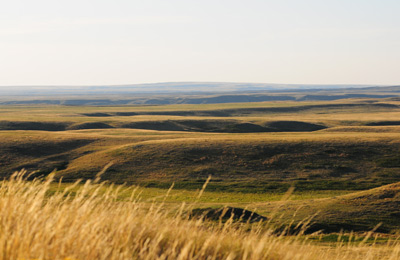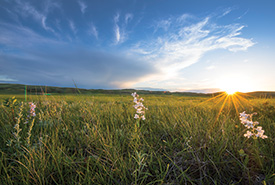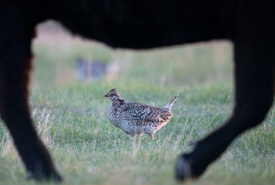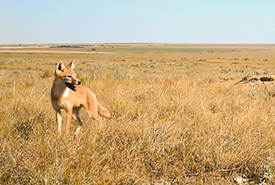Growing harmony: Agriculture and conservation

Wideview, SK (Photo by Calvin Fehr)
Born and raised in Calgary, we took many family camping trips into the Prairies. I was always awed by the massive expanses of grasslands, the endless blue skies, and the diversity of birds, mammals and insects we would see. I remember having to clean our windshield at every stop along the way because the dead bugs accumulated so quickly as we drove along. These days, invertebrate populations have collapsed, the swarms have all but disappeared, and I don’t think my kids even know that gas stations have squeegees. We can think of our too-clean windshields as the canary in the coal mine: Prairie ecosystems are in trouble, and our agricultural productivity may follow if we don’t act.
Prairie grasslands are workhorses, absorbing and storing billions of tonnes of carbon, providing protection from flooding and drought, and helping purify our water. These landscapes, spanning much of southern Alberta, Saskatchewan and Manitoba, also play an important role in agriculture. More than 70 per cent of Canada’s agricultural land mass is found across this region.
We rely on the food grown on this land every day; land that is typically converted from natural ecosystems and accompanied by a loss of biodiversity. Across Canada’s Prairie grasslands, less than 20 per cent of these natural habitats remain intact, and more is lost every year.

Grasslands, MB (Photo by Jason Bantle)
Recognizing the importance of agriculture to humanity and the potential for better harmony between production and conservation, the Kunming-Montreal Global Biodiversity Framework created Target 10 to ensure that areas of agriculture, and other productive sectors, are managed sustainably.
A recent survey conducted by Abacus on behalf of the Canadian Wildlife Federation suggests that the vast majority (greater than 75 per cent) of Canadians are unfamiliar with our native Prairie ecosystems, or that they are one of the most endangered ecosystems on the planet. Yet, the same study demonstrates that once informed, Canadians are supportive of efforts to conserve what remains. We need to ensure that the significance of our Prairies, and the agricultural stewards who keep these places functional and thriving, remain a secret no longer.
Precious, productive lands
While much can be achieved through more sustainable agricultural practices across the country, the grazing of cattle on our native Prairie grasslands provides Canada with a fortuitous opportunity where food production and biodiversity can be mutually beneficial.

Cow and sharp-tailed grouse at NCC's Mackie Ranch (Photo by Jason Bantle)
Ranches require large, contiguous blocks of intact grasslands for grazing, and they contribute significantly to biodiversity conservation in the agricultural context. Ranches make up just over a third of Canada’s agricultural land use, yet nearly 70 per cent of wildlife found on agricultural lands are found on ranches. Numerous studies have demonstrated the positive impact sustainable cattle grazing has on grassland health and the plants and animals that live there. This includes endangered species with specific habitat requirements and many grasses and other plants that thrive in grazed landscapes. Cows and other large grazing mammals are effective at dispersing seeds long distances, and their dung offers an injection of nutrients into the landscape.
Evolving tools and approaches to accelerating conservation
It is crucial that NCC prioritizes the most effective and efficient conservation opportunities available. Its work is rooted in an evidence-based decision-making process that incorporates high-quality information from collaborators across the country, representative of diverse worldviews and lived experiences, supplemented by NCC’s open-source spatial analysis toolkit. This process allows us to be sure that our efforts are resulting in durable outcomes and creating resilient landscapes.
The Canadian Prairies are one of the most densely settled areas in Canada, and there is a high degree of overlap between key biodiversity areas and privately owned lands in this region. Additionally, 75 per cent of the remaining intact Prairie grasslands exist on private agricultural lands. To achieve durable conservation outcomes requires interested landowners, and tools that allow for partnership.

Waldron Co-Operative at Bob Creek Ranch (Photo by Sean Feagan / NCC Staff)
Conservation agreements are an effective mechanism to formalize such partnership: a landowner can remain on their land operating their ranch in a way that is compatible with biodiversity outcomes, and legal restrictions are placed on title that prevent future development or conversion of the ecosystem. These agreements are built through mutual agreement and trust, and have proven to be cost-effective and reliable forms of conservation.
The Waldron Conservation Project exemplifies what good conservation practices can look like. Composed primarily of native habitat, the Waldron Ranch is an area of incredible diversity, rich history and spectacular scenery. Conservation and productive ranching have always worked together at the Waldron. To ensure this would be true in perpetuity, in 2013 NCC and the Waldron Grazing Co-Op agreed to the terms of a conservation agreement. In the decade since, the ranch and NCC’s relationship with the co-op have thrived. NCC is building on this success with a project at Bob Creek Ranch, an adjacent Prairie grasslands property.
Shedding light on the grasslands
We have one last opportunity in the Prairies to ensure that our grasslands’ plants and animals continue to thrive, thanks to generations of stewardship by the people who have lived in, worked on and cared for these grasslands. It is imperative that Canadians recognize the significance of this landscape, and the value that these grassland champions have provided to all of us, and that we find ways to ensure such efforts are supported.

Swift fox in southern Alberta (Photo by NCC)
In 2024, NCC launched the Prairie Grasslands Action Planto conserve 500,000 hectares of Prairie grasslands by 2030. NCC works to protect land with the goal of supporting continued use, whether industry or recreational, in compatibility with conservation principles. This approach balances promoting livelihoods and recreation while addressing the twin crises of biodiversity loss and climate change. We all have a role to play in raising awareness of the importance of these places, and we need everyone at the table to help ensure their future, so that these working landscapes continue to work for
Follow us on LinkedIn and join the conversation!


